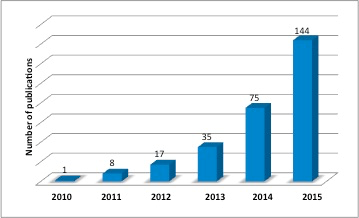Tracking scientific publications based on data generated from AMPTS
Bibliometric indicators based on publications in international, peer reviewed journals can be used to explore the current impact of Bioprocess Control’s automatic technologies in the biogas field.
Bibliometric indicators (e.g. quantity and structural indicators) for measuring the number of scientific publications related to the Automatic Methane Potential Test System (AMPTS II) and their regional distribution around the world have been studied from 2010 to 2015 using available data from a number of literature databases. There are indications that the growth rate of publications in peer-reviewed journals is increasing exponentially.

Figure 1. Increase in number of scientific publications related to AMPTS II in biogas field between 2010 and 2015.
The same pattern is also followed by publications using new channels, for example conference proceedings, newspapers and magazines, home pages, etc. A selection of scientific publications is presented here on Bioprocess Control’s website.
A bibliometric indicator measuring the distribution of scientific articles published by universities or research companies around the world is presented in Figure 2. By looking at the number of publications co-signed by authors from different countries at the end of 2015, 67% were published by authors with contact addresses in Europe, 22% in Asia, 9% in America and the rest in Africa. As it can be clearly seen, Europe dominated with regard the total number of collaborative papers focused on AMPTS II.

Figure 2. Distribution of scientific articles around the world based on data generated from AMPTS II.
The wide range of applicability for AMPTS II* and the increasing rate of publications in the most recent three years suggest that a further rate growth in publications based on data generated by Bioprocess Control’s product portfolio could be anticipated.
*E.g. determination of methane potential and dynamic degradation profile of organic substrates, evaluation of biomass pre-treatment strategies, measurement of specific methanogenic activity of bacteria, study of the effects of enzymes and nutrients on a biological process, process optimization by screening large amounts of variables which affect the outputs, etc.

